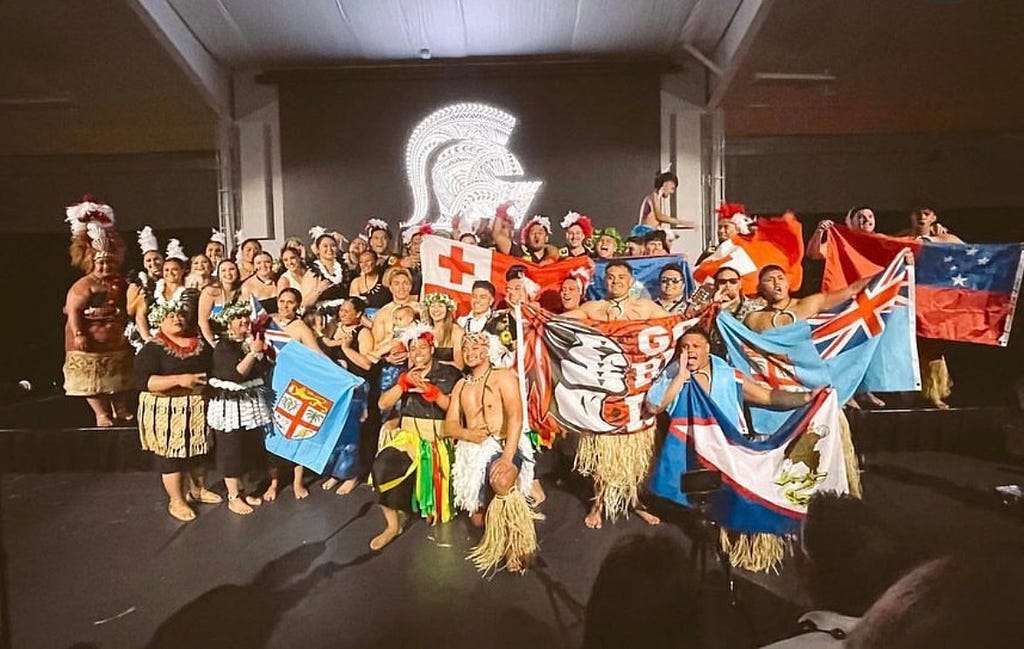By Olivia Norton
The Polynesian Heritage Association wraps up its time at Southern Virginia University with an unforgettable performance.

Kia Ora! Aloha! Ia Orana! Malo E Leilei! Bula Vinaka! Talofa Lava! These are the greetings of the six islands that were represented this past Friday on April 21 here at Southern Virginia University.
Most people wouldn’t expect to find a strong community of Polynesians nestled between the Shenandoah mountains, but they are here and they are proud to share who they are. This group of Polynesians, as well as friends and family who are interested in supporting and learning their culture, make up the Polynesian Heritage Association (learn more about the association here). For the entire year, the PHA members put in countless hours of song and dance practice all for one performance: the Luau. This year the theme of the Luau was “Back to Our Roots,” and the PHA did not disappoint in showing the traditions of where they came from! All the numbers performed at the Luau were either passed down from ancestors or choreographed by Southern Virginia PHA members based on the traditions they were taught growing up.
The Luau started out with the island of Aotearoa, or New Zealand. Led by Abigail and O’Shea Settle, the Māori section started their performance with a song called “Ko Te Whaea,” a tribute to Mother Mary. Next, they performed a short Poi dance to “Papaki,” and then wrapped it all up with a very moving traditional Haka called “Poropeihana.”
The next island represented was Hawaii. The numbers performed were passed down by the Burke family. It started off with an Ole, or chant, led by Co-Presidents Kaehukai and Kilihea Burke. They then performed a combined number to “Ka Huaka’i,” followed by traditional Hula Kahikos by the men to “Ke Ahi Alapa,” and then to “Ka Wahine O Kalua” by the women. These three dances told stories of the fire and volcano goddess Pele, who created the Hawaiian Islands. The last performance of the Hawaiian section was the Co-Presidents’ wedding song to “E Ku’u Sweetie,” which was performed by the Co-Presidents, along with Kaehukai’s parents.
The Tahiti section was next. They performed a couple’s dance to the song “Pate Pate.” Although there was only one number performed in the Tahitian section, it did not disappoint with its fast-paced hip and leg movements! This dance highlighted the similarities, differences, and balance between the male and female styles of Tahitian dancing.
Tahiti was followed by Tonga, where they greet you with “Malo E Leilei!” The Tongan section started with an intro dance by both the men and women. The men then exited the stage and the women performed a group Tau’olunga to the song “Kalipolina.” The men came back on stage and performed a Mako, a fast-paced dance performed by young men. Then the Tongan section performed a Lakalaka, which is a combined dance. The next number was a song called “Ke Tau Hiva Fiefia,” where audience members who knew the song were invited to come onstage and join in the singing. The final performance of the Tongan section was a Tau’olunga performed by Kalo Vaea who came all the way from Washington state to perform.
Fiji was next up in the line up and did not disappoint with their Meke. A Meke is a combination of dance and story-telling through song, and is a collaboration between men and women. The section started with the men singing a chant. They then performed spear and fan dances to “Rau Vula Rau Tau” and “Noqu Moce.” The women were up next with a short dance to “Vunileba” that showed off their grace in contrast to the masculine dances prior. More dancers flooded the stage and the Fiji section ended their performance with a combined dance to “Turki Tura,” with the women using fans and the men using clubs.
The last island was Samoa. The men started with a Fa’ataupati, or slap dance. The women then took over the stage and performed a Siva to the song “La’u Samoa.” They were then joined once again by the men and led by Taniela Faletau in a Sasa, which is a dance that displayed a combination of sitting, standing, and impressive fast-paced clapping movements. The dancers exited the stage so that senior Rita Kennach could perform a traditional Samoan Taualuga. The cherry on top of the Samoan section was the Ailao Afi, or fire knife dance that was performed by Sikeli Naivalu and Maikeli Tuinakavadra, and had the entire audience on the edge of their seats and the arena filled with “cheehoos!”
To end the night, all of the members of the Polynesian Heritage Association came together and sang an arrangement of songs from all the islands. They were accompanied with live music, which was played throughout the night by Aiden Ancog, K.T. Tilini, and Kaponi Vakalahi. As the song ended the crowd that packed the arena jumped to its feet in applause. It truly was an unforgettable performance!
The Polynesian Heritage Association worked hard to bring this gift to the school. They are so grateful for all of the parents and family members that traveled to watch the performance, as well as all of the other supporters that came to show the PHA their love. The PHA faced a lot of hardship this past year, and they appreciate the support that so many have shown. This was the last year of the Polynesian Heritage Association being connected to Southern Virginia University, as they recognize the value of embracing new opportunities and growth as an independent organization. But don’t worry, this is certainly not the end of PHA and there are more performances coming in the future!
(Click here to watch a recording of the Luau!)
A Luau in Virginia was originally published in The Herald on Medium, where people are continuing the conversation by highlighting and responding to this story.

